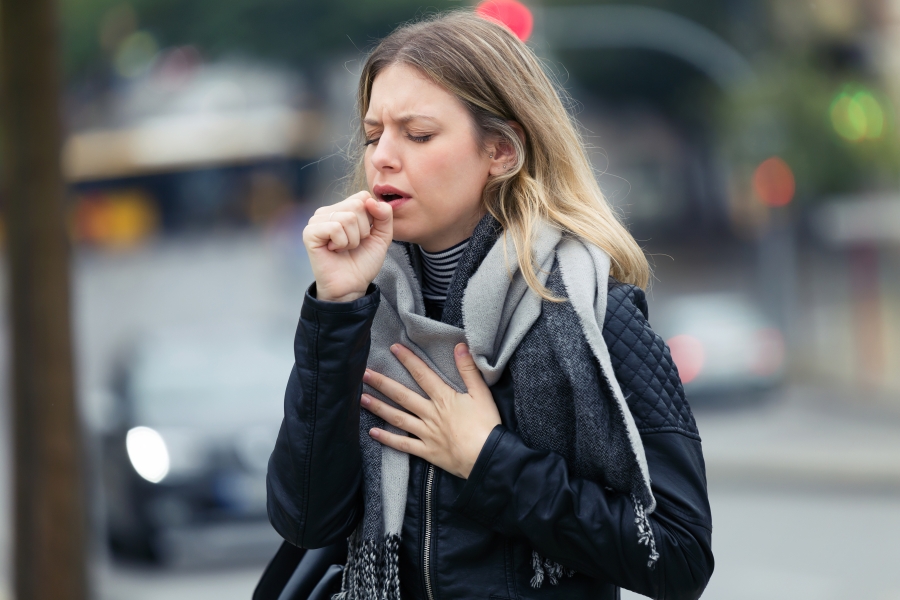Are you living with a cough that won’t quit? Many conditions can cause a persistent cough, but if your chronic cough produces a lot of mucus, one possible explanation is a chronic lung disease called bronchiectasis.
Bronchiectasis isn’t as common as some other lung diseases, so many people haven’t heard of it — and don’t know that treatment is available. This condition occurs when the airways in the lungs are damaged in a way that causes them to widen and become “floppy.”
The damaged airways lose their ability to clear mucus out of the lungs. Instead, mucus accumulates there, setting the stage for frequent bacterial infections that can damage the lungs even more.
Bronchiectasis can significantly affect a person’s quality of life. Constant congestion and coughing is uncomfortable, and can make it hard to sleep through the night. Additionally, some of my patients tell me that they feel embarrassed from coughing frequently while in public.
Even though there is no cure for bronchiectasis, the good news is that the condition is treatable.
If you are living with bronchiectasis — or if you’re living with a chronic cough that might be bronchiectasis — it’s important to understand your condition, what might be causing it, what you can do about it, and how seeing specialists experienced in this rare condition can help.
Here are five key facts I wish everyone knew about bronchiectasis:
1. Bronchiectasis is often caused by other conditions.
Many people with bronchiectasis have an underlying disorder that damages the lungs. Cystic fibrosis, a genetic disorder that affects the lungs and other organs, is the most common of these. Nearly half of people with bronchiectasis have cystic fibrosis.
Other conditions that can cause bronchiectasis include the following:
- Immune system disorders, such as HIV or immunoglobulin deficiency.
- Airway blockages caused by tumors or noncancerous growths.
- Inflammatory bowel disease, such as Crohn’s disease or ulcerative colitis.
- Chronic obstructive pulmonary disease (COPD), an inflammatory lung disease which includes emphysema and chronic bronchitis.
- Severe lung infections, including pneumonia or tuberculosis.
Sometimes the underlying reason for bronchiectasis is unknown, but that doesn’t mean the condition itself can’t be treated.
People of all ages can get bronchiectasis. Cystic fibrosis is almost always diagnosed at birth or before two years of age. In rare instances, children who don’t have cystic fibrosis can be born with bronchiectasis. But in general, the risk of bronchiectasis rises with age.
2. Coughing up mucus is a common symptom.
The most common symptom of bronchiectasis is a chronic cough that produces a lot of mucus.
Other signs and symptoms include:
- Shortness of breath
- Chest congestion
- Wheezing (a whistling sound when you breathe)
- Clubbing — or rounded appearance — of the tips of the fingers or toes
- Coughing up blood with mucus, caused by chronic inflammation of the airways
- Recurring pneumonia or other lung infections
These signs and symptoms may develop over the course of months or even years.
At times, the symptoms of bronchiectasis can worsen. I tell my patients that these flare-ups are usually triggered by an infection, which then increases the amount of mucus in the lungs.
3. An early diagnosis is important.
As I tell my patients, diagnosing bronchiectasis early can be key: The sooner you start treatment, the sooner you can begin to improve your symptoms and help prevent more lung damage.
At the Temple Lung Center, we usually use a CT scan of the lungs to diagnose bronchiectasis. These scans often allow us to see the large, widened airways that are indicators of the condition.
In some cases, I have my patients undergo breathing tests that measure lung function. These tests, called pulmonary function tests, help doctors see how well the lungs are working and the degree of lung impairment a patient may be experiencing.
In addition, I may recommend blood, sweat, or other tests to find any underlying treatable causes, such as cystic fibrosis.
4. Temple has a dedicated bronchiectasis program.
Without proper treatment, bronchiectasis can do more than just decrease a person’s quality of life — it can sometimes lead to other issues, such as respiratory failure. That’s why it’s important to receive treatment from healthcare providers who are experienced with this condition. That’s just what you’ll find at Temple Lung Center.
At Temple’s dedicated Bronchiectasis Program, patients are treated by a multidisciplinary team of specialists, including pulmonologists, respiratory therapists and thoracic (chest) surgeons.
At Temple, we tailor the treatment plan to each patient’s needs. Some of the treatments we use to help clear mucus from the lungs include:
- Inhaled anti-inflammatory medications that patients take with a nebulizer, a device that turns the medicine into an inhalable mist. These medications help decrease mucus production, which helps make breathing easier.
- Oral antibiotics to help treat infections that trigger bronchiectasis flare-ups. Sometimes we prescribe antibiotics that also have anti-inflammatory properties, because these medications destroy bacteria and help decrease airway inflammation.
- A wearable therapy vest that uses pulsed air to vibrate the chest wall. Called high-frequency chest-wall oscillation, this therapy helps release mucus from the airway walls, making it easier to cough it out. Patients generally wear their therapy vest two or three times a day.
- A flutter valve, a handheld therapy device that you blow into. It creates positive pressure and vibrations in your airways, which helps loosen mucus.
- Postural techniques and chest physical therapy to help drain mucus from the lungs. Our respiratory therapists can show you how to position your body to relieve congestion. They can also teach you and a caregiver to use chest physical therapy by clapping on your chest and back to help loosen mucus.
- Pulmonary rehabilitation, which consists of a program of exercise and lung disease education to improve your lung function and overall health.
- Oxygen therapy if a person may not be getting enough oxygen to meet their body’s needs.
- Surgery is not often used to treat bronchiectasis, but it may benefit some people, such as those who have excessive bleeding in their lungs. Surgery generally removes the damaged part of the lungs. When appropriate, a Temple thoracic surgeon may review your case to see if you might benefit from surgery.
- Treatments to control underlying conditions that may have caused your bronchiectasis.
5. You’re the most important member of your bronchiectasis treatment team.
Although bronchiectasis is a chronic condition — which means it doesn’t go away — there are things you can do to improve your quality of life and help prevent flare-ups.
These steps may include:
- Following your treatment plan, including taking medications as directed and getting regular checkups. Call your doctor right away if you experience a sudden worsening of your symptoms — for instance, if you’re coughing a lot more, having trouble breathing, or coughing up mucus that is bloody or a different color than usual.
- Avoiding lung infections. Keep your distance when other people are sick; wash your hands often; and stay up-to-date on vaccines.
- Staying hydrated. Drinking enough fluid helps keep mucus thin and easier to manage.
- Exercising. Physical activity can help loosen mucus and strengthen your breathing muscles and improve your overall health.
- Quitting smoking. Smoking does not cause bronchiectasis, but not smoking will help protect your lungs from further damage. So if you smoke, try to quit.
Get the lung care you deserve
The experts at Temple’s Bronchiectasis Program specialize in helping patients with this rare disorder improve their quality of life. We provide our patients with the expertise and support they need to manage their symptoms and feel their best.
Request an appointment with a Temple pulmonologist or call 800-TEMPLE-MED (800-836-7536) today.
Helpful Resources
Looking for more information?

